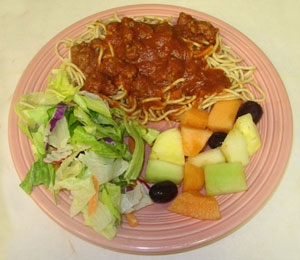Posts Tagged: obesity
EFNEP helps us eat well on the cheap
Last week (Jan. 31, 2011) the U.S. Department of Agriculture released its revised 2010 Dietary Guidelines for Americans. They are “the federal government's evidence-based nutritional guidance to promote health, reduce the risk of chronic diseases, and reduce the prevalence of overweight and obesity through improved nutrition and physical activity,” according to the press release.
I scanned the press release for news that cookies have been designated an essential food group. No luck. I confess, I didn’t read the entire 95-page pdf, but surely any such rocking revelations would have been reported in the press release.
Because more than one-third of children and more than two-thirds of adults in the United States are overweight or obese, the guidelines emphasize eating less and moving more.
I wasn’t surprised to see among its 23 key recommendations the advice to drink more water instead of sugary drinks, eat a variety of healthy foods and reduce salt. I expected the recommendation to eat more fruits and vegetables, but now it’s more explicit.
They say half of my plate should be covered in fruits and veggies. And mix it up – eat a variety of vegetables and protein sources. (I used to eat broccoli beef almost every day for lunch, until the day I found an insect in it.)
Many people think they have to spend more for nutritious meals, that fresh produce and meat are expensive. However, UC’s Expanded Food and Nutrition Education Program, or EFNEP, gives tips on how to make healthful food choices when you’re on a limited income. (Unless your name is Mark Zuckerberg, whose income isn’t limited?)
Chapter 6 of the Dietary Guidelines acknowledges that our environment – composed of school, workplace, social groups, culture and so on – influences our food and exercise choices. However, our communities don’t excuse our behavior because ultimately we make our own choices, it essentially says. We may have more access to healthy foods and opportunities to engage in physical activity than we realize. Connie Schneider, EFNEP Council chair, sees EFNEP as a vehicle to help families navigate their complicated food environments.
“Our educators facilitate group discussions to resolve food issues from shopping on a budget to getting their children to eat healthier foods,” said Schneider, who is also a UC Cooperative Extension nutrition advisor.
The EFNEP staff meets with families and children in a variety of community settings, including schools, shelters and transitional housing. Nutrition educators teach them how they can stretch their food dollars and still enjoy a healthy diet. They share recipes for nutritious meals that are simple to prepare as well as inexpensive. I love to eat, but have little patience for cooking. Watching a nutrition educator demonstrate how to make chili, I found myself thinking, “That’s so quick and easy, even I would do that.”
Sometimes a new way of preparing a familiar vegetable encourages me to eat more veggies.
The EFNEP website spotlights a Fresh Pick of the Month, such as cauliflower. The site gives the nutritional benefits of cauliflower, serving tips and recommendations for handling and storing the vegetable. It also provides a recipe for cauliflower soup.
The nutrition educators also publish monthly newsletters, in English and Spanish, featuring a recipe and healthful suggestions, such as walking to the restaurant and sharing entrees when you go out to eat. Although the nutrition program is designed to assist families and children whose resources are limited, we can all use the suggestions to improve our health and save some money.

EFNEP enchilada casserole preparation
How to really lose that 5 pounds this year: Be realistic, think positive
Have you resolved to lose 5 pounds in 2011?
Join the club.
Losing a little weight is a perennial goal on many people’s New Year’s resolution list … and failure to achieve that goal is the primary reason why we keep resolving to lose that 5 pounds year after year.
Judith S. Stern, UC Davis nutrition professor and author of hundreds of articles on obesity and nutrition, says that setting a weight-loss goal is a good thing. “If you don’t make a resolution, you don’t have something to reach for. Resolutions are about hope.”
But no one said it was going to be easy. “Losing weight is even harder than quitting smoking. You can always not smoke, but you can’t not eat,” Stern says. “You’ll die without food.”
However, Stern — who has been on her own weight-loss journey — advises resolution-makers to set realistic weight-loss goals. Here are her recommendations:
- Keep a journal of what you eat and write down your weight every day. “We need cues to help us deal with weight,” Stern says.
- Buy a scale that registers to one-tenth of a pound. “Those whole pounds can be hard to deal with,” Stern says. “I tell my husband when I’ve lost two-tenths of a pound.”
-
Get a pedometer, and steadily increase your average daily numbers (rather than, for example, trying to achieve the recommended 10,000 steps per day at the start). “If I don’t make my numbers, I walk around my house and put things away one at a time,” Stern says. “When I started I was walking 3,000 steps per day, and now I’m averaging around 8,000 steps.”
- Aim to lose about 3 to 4 pounds per month.
Most importantly, frame your weight-loss resolution in a way that doesn’t court failure. Setting short-term goals is a good way to go, such as losing 3 pounds in 3 weeks, or exercising 10 times in the coming month.
A positive resolution for many people, especially those who have already lost some weight, may be to simply maintain their current weight throughout the year.
“When you make a New Year’s resolution, think about what you want to accomplish. Figure out how to do it so that you feel good about yourself,” Stern says.
Community gardening cultivates well-being
An innovative pilot gardening project, "LA Sprouts," produced significant improvements in the health of the participating children. They gained less weight than their peers who did not participate and saw a significant improvement in their body mass index. Equally important, motivation to eat and preferences for fruits and vegetables increased. Students learned about soil health, watering, recycling, and how to plan a garden, compost and cook what they grew.
With funding from the Kaiser Foundation Hospital - Los Angeles, researchers from USC and UCLA, and master gardeners from UC Cooperative Extension's Common Ground Garden Program offered the gardening and nutrition intervention pilot project to a group of Los Angeles elementary school students, most of whom are Latino.
The 12-week project took place at the Milagro Allegro Community Garden in the Highland Park neighborhood of Northeast Los Angeles. What sprouted was quite inspirational.
"Encouraging our children to explore, grow, touch, smell, pick, prepare and eat their own organic fruits and vegetables will provide a positive healthy future for the rest of us," says Milli Macen-Moore, resident Master Gardener of the Milagro Allegro Community Garden.
The promising results will be published in two peer-reviewed journals, Journal of the American Diabetic Association and Public Health Nutrition, and the pilot study's coordinators expect the intervention to be effective in preventing obesity with a longer intervention period. The garden-based nutrition education study is the first of its kind to evaluate obesity-related parameters.
The Milagro Allegro Community Garden was founded in 2009 by Nicole Gatto, assistant research professor at UCLA. The site integrates urban farming, art and education in the heart of Northeast Los Angeles and acts as a center where peace and beauty exist among the growing fruits, vegetables and flowers. The garden features 32 raised bed plots and accommodates more than 40 families.
For more information about the study or community garden, visit the Milagro Allegro Community Garden website and/or contact Gatto at info@hpgarden.org.
Obesity is linked with low earnings
Minimum-wage employees are more likely to be obese than those who earn higher wages, according to a new study by UC Davis public health researchers. The study is the latest in a growing body of evidence that shows being poor is a risk factor for unhealthy weight.
"Estimating the Effects of Wages on Obesity" was published in May 2010 in the Journal of Occupational and Environmental Medicine. The authors, DaeHwan Kim and John Paul Leigh, identified several possible reasons why lower wages could support the tendency to be obese:
- Poorer people tend to live in less-safe neighborhoods with reduced access to parks and other means of physical activity
- Healthy, lower-calorie foods tend to be more expensive
- Low-income families have less access to healthier foods and often have to travel greater distances than others to find healthier food options and lower cost
"The outcome leads us to believe that raising minimum wages could be part of the solution to the obesity epidemic," Leigh said.
In a news release, Leigh noted that a novel statistic technique used for the study gave the scientists a chance to evaluate an independent factor that is definitely not caused by obesity - minimum wages.
UC Davis Cooperative Extension nutrition specialist Sheri Zidenberg-Cherr said experts are aware of the higher incidence of obesity among the poor, and believe that the causal relationship may go both ways.
"We know there have been cases of discrimination against the obese seeking employment for various types of positions," Zidenberg-Cherr said. "It is also true that, for minimum-wage earners, it is easier and cheaper to buy foods that are high in fat and sugar. They may not have the access or the education to make healthy food choices."
Leigh noted that the scientists' sample for the study were 85 percent men and 90 percent Caucasian.
"Future research should address wage and obesity correlations among samples that include more African-Americans, Hispanics, Asians and women," Leigh said. "Obesity is a complex problem that likely has multiple causes. The more we can pinpoint those causes for specific populations, the greater chances there are for reducing its impact."

Low wage earners are more likely to be obese.
Good food for all: L.A. tackles food policies
With a population of more than 10 million residents, Los Angeles County faces enormous challenges related to poverty and hunger. Over a million L.A. County residents face hunger or food insecurity every day, according to the Los Angeles Regional Food Bank. A Sept. 6 Los Angeles Times article detailed the problems faced by local food pantries, as they struggle to cope with a demand for food that’s risen by 48 percent in just two years. At the same time, with cheap fast food, and limited access to affordable healthy food, childhood obesity is an increasingly critical problem. Forty percent of middle-school age children in Los Angeles County are now classified as overweight or obese.
Local elected officials are embarking on an effort to more systematically address these issues. Last fall, Los Angeles Mayor Antonio Villaraigosa convened a group of experts, bringing together community organizers, restauranteurs, public health experts, employers, farmers, urban gardeners and others to form the Los Angeles Food Policy Task Force. This was a short-term effort to gather information and make recommendations to the mayor and decision makers. The task force recently released a report, “The Good Food for All Agenda: Creating a New Regional Food System for Los Angeles,” outlining an ambitious plan for improving access to healthy food in Los Angeles.
The task force defined “good food” as food that is healthy, affordable, fair (meaning that all participants in the food supply chain receive fair compensation) and produced sustainably, using principles of environmental stewardship.
Some of the task force's recommendations were:
- Develop a regional food hub, which can coordinate supply and demand for local, sustainable food. (Farms in several counties were included in the definition of “local” for the Los Angeles area).
- Encourage school districts to procure sustainable, local food and provide children with higher quality lunches.
- Promote and improve participation in the Supplemental Nutrition Assistance Program (SNAP), formerly known as the Food Stamp Program.
- Facilitate neighborhood food production by streamlining permits for community gardens, and expanding joint use agreements where schools offer their land for community gardens.
- Start an ongoing regional food policy council, which will include both city and county decision makers and community leaders.
While Los Angeles is just one of a number of major metropolitan areas to form a task force of this nature, it’s exciting to see the state (and nation’s) most populous county addressing food policy issues. Although Los Angeles County has a relatively small number of farms, neighboring counties, including Ventura, still have significant commercial agriculture. Policies like those recommended by the L.A. Task Force not only improve choices and healthy options for consumers, they can also lead to new markets for local farmers.
UC ANR programs, such as UC Cooperative Extension in Los Angeles County, offer research-based expertise in urban gardening, nutrition education, sustainable food production and more, and serve as a resource for local policymakers and residents working to improve food access. To learn more about the L.A. Food Policy Task Force and read the Good Food for All Agenda, see http://goodfoodla.org/.

Improving access to local produce is part of the "Good Food For All" Agenda.




